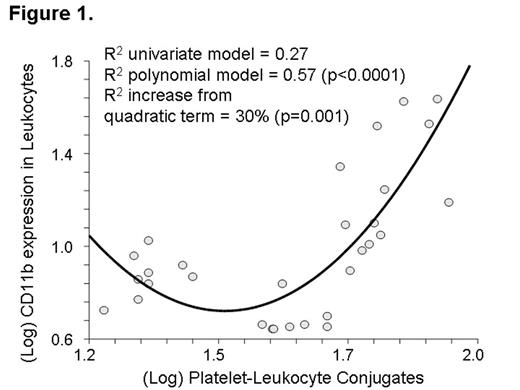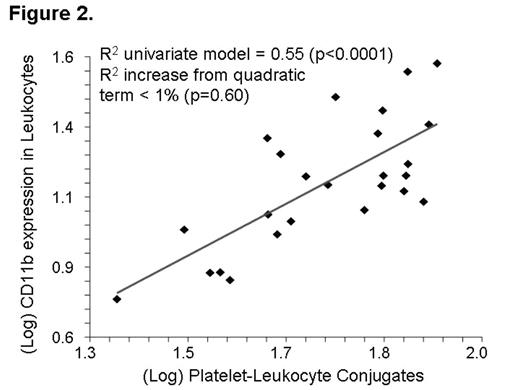Abstract
Background: Platelet binding to leukocytes has been shown to induce leukocyte activation in vitro. It is unknown to what extent platelet binding to leukocytes regulates leukocyte activation in vivo. We examined the correlation between platelet binding to leukocytes (platelet-leukocytes conjugates) and leukocyte activation in various clinical conditions.
Methods: We studied a total of 321 venous blood samples from 291 subjects with acute venous thromboembolism (n=25), atrial fibrillation (n=48), metabolic syndrome (n=37), congestive heart failure (n=44), antiphospholipid syndrome (n=70), early sepsis (n=35), late sepsis (n=30) and normal controls. Using flow cytometry, we measured leukocyte expression of activation marker CD11b. Platelet-leukocyte conjugate measurement was based on co-expression of CD41 and CD45.
Results: Levels of platelet-leukocyte conjugates strongly correlated with CD11b expression. This finding was present in congestive heart failure (r=0.47; p=0.001), atrial fibrillation (r=0.32; p=0.02), metabolic syndrome (r=0.51; p=0.001), venous thromboembolism (r=0.74; p<0.0001), early sepsis (r=0.70; p<0.0001), late sepsis (r=0.66, p=0.0002), and antiphospholipid antibody syndrome (r=0.53; p<0.0001). In normal controls, the relationship between platelet-leukocyte conjugates and CD11b expression was best described by a 2nd-degree polynomial model, which included the quadratic term platelet-leukocyte conjugates squared, suggesting a threshold effect. The quadratic term added significant prediction of CD11b expression, demonstrating a highly significant exponential increase in CD11b expression after a threshold level of platelet-leukocyte conjugates is reached (model R2=0.57; r2 increase from quadratic term=29%; p=0.0001), as shown in Figure 1. This threshold was not seen in any disease state examined (all p for quadratic terms > 0.05). For example, the relation between platelet-leukocyte conjugates and CD11b expression in venous thromboembolism is shown in Figure 2, and is best described by a straight line. The addition of quadratic term did not add any prediction of CD11b expression, as shown.
Conclusions: Our findings strongly suggest that platelet binding to leukocytes is a key determinant of leukocyte activation in vivo. The degree of platelet binding to leukocytes strongly correlates with leukocyte activation after a threshold is reached in normal adults. This threshold is lost in pro-thrombotic and pro-inflammatory disease states, in which a linear increase in leukocyte activation is seen with increasing platelet binding to leukocytes.
Author notes
Corresponding author



This feature is available to Subscribers Only
Sign In or Create an Account Close Modal